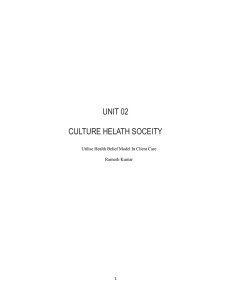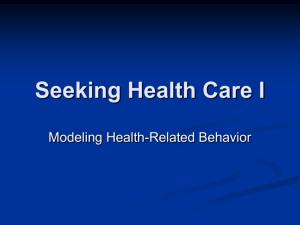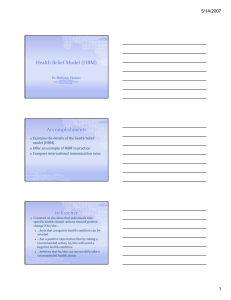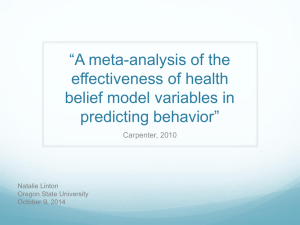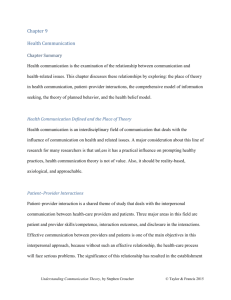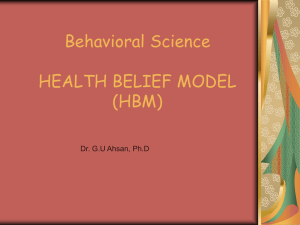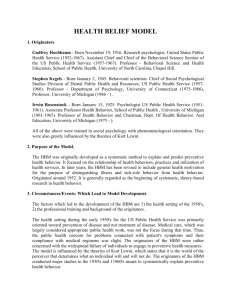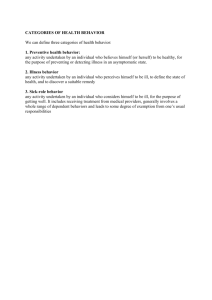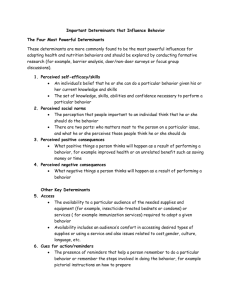Health Belief Model
advertisement
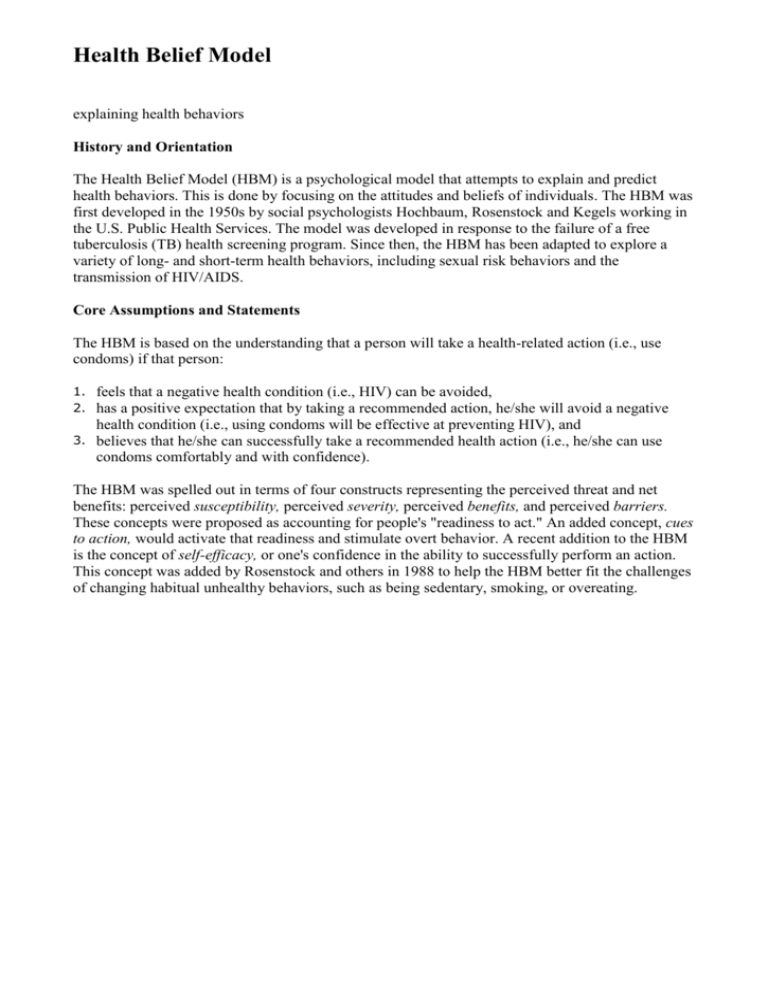
Health Belief Model explaining health behaviors History and Orientation The Health Belief Model (HBM) is a psychological model that attempts to explain and predict health behaviors. This is done by focusing on the attitudes and beliefs of individuals. The HBM was first developed in the 1950s by social psychologists Hochbaum, Rosenstock and Kegels working in the U.S. Public Health Services. The model was developed in response to the failure of a free tuberculosis (TB) health screening program. Since then, the HBM has been adapted to explore a variety of long- and short-term health behaviors, including sexual risk behaviors and the transmission of HIV/AIDS. Core Assumptions and Statements The HBM is based on the understanding that a person will take a health-related action (i.e., use condoms) if that person: 1. 2. feels that a negative health condition (i.e., HIV) can be avoided, has a positive expectation that by taking a recommended action, he/she will avoid a negative health condition (i.e., using condoms will be effective at preventing HIV), and 3. believes that he/she can successfully take a recommended health action (i.e., he/she can use condoms comfortably and with confidence). The HBM was spelled out in terms of four constructs representing the perceived threat and net benefits: perceived susceptibility, perceived severity, perceived benefits, and perceived barriers. These concepts were proposed as accounting for people's "readiness to act." An added concept, cues to action, would activate that readiness and stimulate overt behavior. A recent addition to the HBM is the concept of self-efficacy, or one's confidence in the ability to successfully perform an action. This concept was added by Rosenstock and others in 1988 to help the HBM better fit the challenges of changing habitual unhealthy behaviors, such as being sedentary, smoking, or overeating. Table from “Theory at a Glance: A Guide for Health Promotion Practice" (1997) Definition Application Perceived Susceptibility One's opinion of chances of getting a condition Define population(s) at risk, risk levels; personalize risk based on a person's features or behavior; heighten perceived susceptibility if too low. Perceived Severity One's opinion of how serious a condition and its consequences are Specify consequences of the risk and the condition Perceived Benefits One's belief in the efficacy of the advised action to reduce risk or seriousness of impact Define action to take; how, where, when; clarify the positive effects to be expected. Perceived Barriers One's opinion of the tangible and psychological costs of the advised action Identify and reduce barriers through reassurance, incentives, assistance. Cues to Action Strategies to activate "readiness" Provide how-to information, promote awareness, reminders. Self-Efficacy Confidence in one's ability to take action Provide training, guidance in performing action. Concept Conceptual Model Source: Glanz et al, 2002, p. 52 Scope and Application The Health Belief Model has been applied to a broad range of health behaviors and subject populations. Three broad areas can be identified (Conner & Norman, 1996): 1) Preventive health behaviors, which include health-promoting (e.g. diet, exercise) and health-risk (e.g. smoking) behaviors as well as vaccination and contraceptive practices. 2) Sick role behaviors, which refer to compliance with recommended medical regimens, usually following professional diagnosis of illness. 3) Clinic use, which includes physician visits for a variety of reasons. Example This is an example from two sexual health actions. (http://www.etr.org/recapp/theories/hbm/Resources.htm) Concept 1. Perceived Susceptibility 2. Perceived Severity 3. Perceived Benefits 4. Perceived Barriers 5. Cues to Action 6. Self-Efficacy Condom Use Education Example Youth believe they can get STIs or HIV or create a pregnancy. Youth believe that the consequences of getting STIs or HIV or creating a pregnancy are significant enough to try to avoid. Youth believe that the recommended action of using condoms would protect them from getting STIs or HIV or creating a pregnancy. STI Screening or HIV Testing Youth believe they may have been exposed to STIs or HIV. Youth believe the consequences of having STIs or HIV without knowledge or treatment are significant enough to try to avoid. Youth believe that the recommended action of getting tested for STIs and HIV would benefit them — possibly by allowing them to get early treatment or preventing them from infecting others. Youth identify their personal Youth identify their personal barriers barriers to using condoms (i.e., to getting tested (i.e., getting to the condoms limit the feeling or they clinic or being seen at the clinic by are too embarrassed to talk to their someone they know) and explore partner about it) and explore ways ways to eliminate or reduce these to eliminate or reduce these barriers (i.e., brainstorm barriers (i.e., teach them to put transportation and disguise options). lubricant inside the condom to increase sensation for the male and have them practice condom communication skills to decrease their embarrassment level). Youth receive reminder cues for Youth receive reminder cues for action in the form of incentives action in the form of incentives (such (such as pencils with the printed as a key chain that says, "Got sex? message "no glove, no love") or Get tested!") or reminder messages reminder messages (such as (such as posters that say, "25% of messages in the school newsletter). sexually active teens contract an STI. Are you one of them? Find out now"). Youth confident in using a Youth receive guidance (such as condom correctly in all information on where to get tested) or circumstances. training (such as practice in making an appointment).
